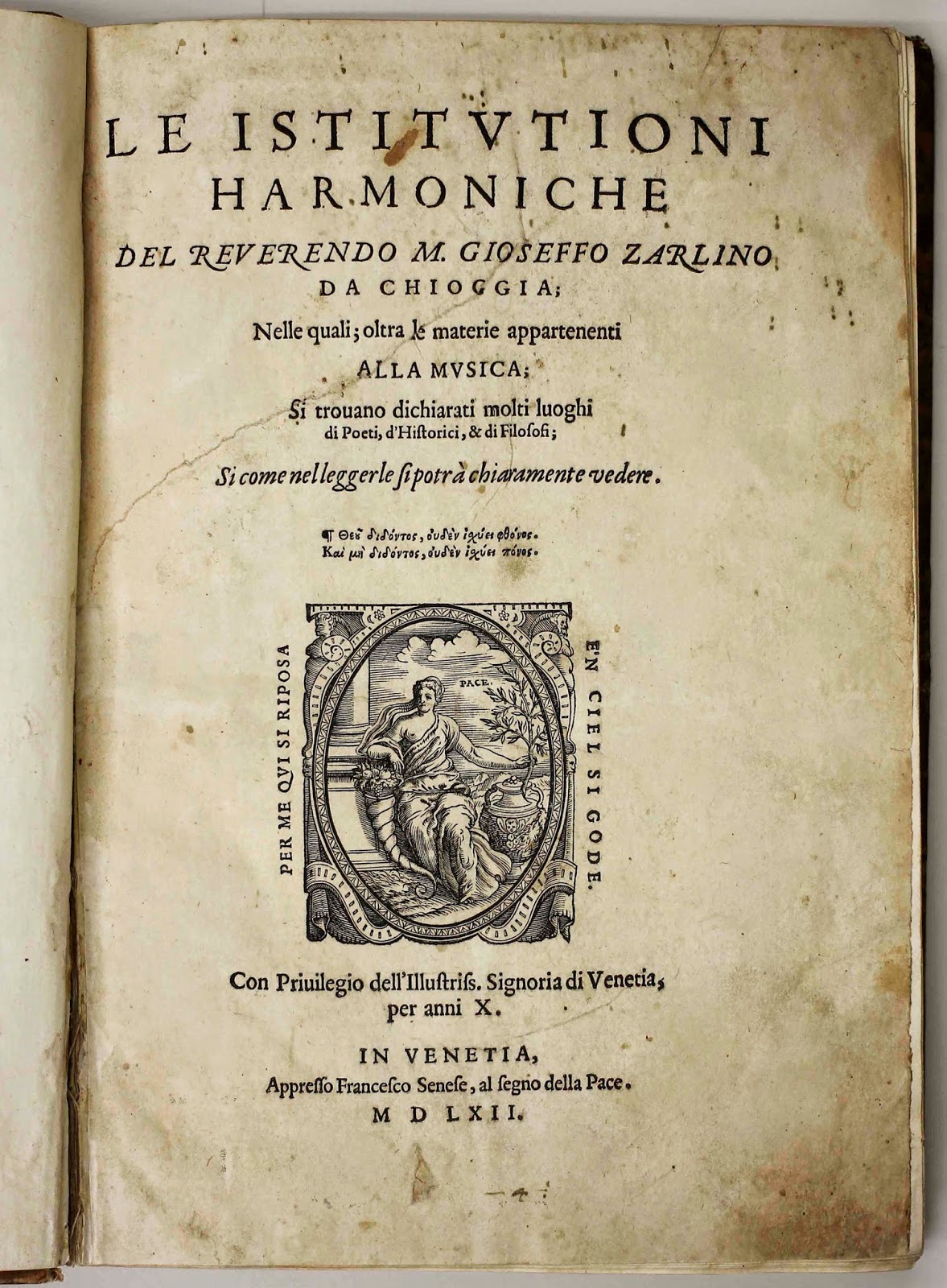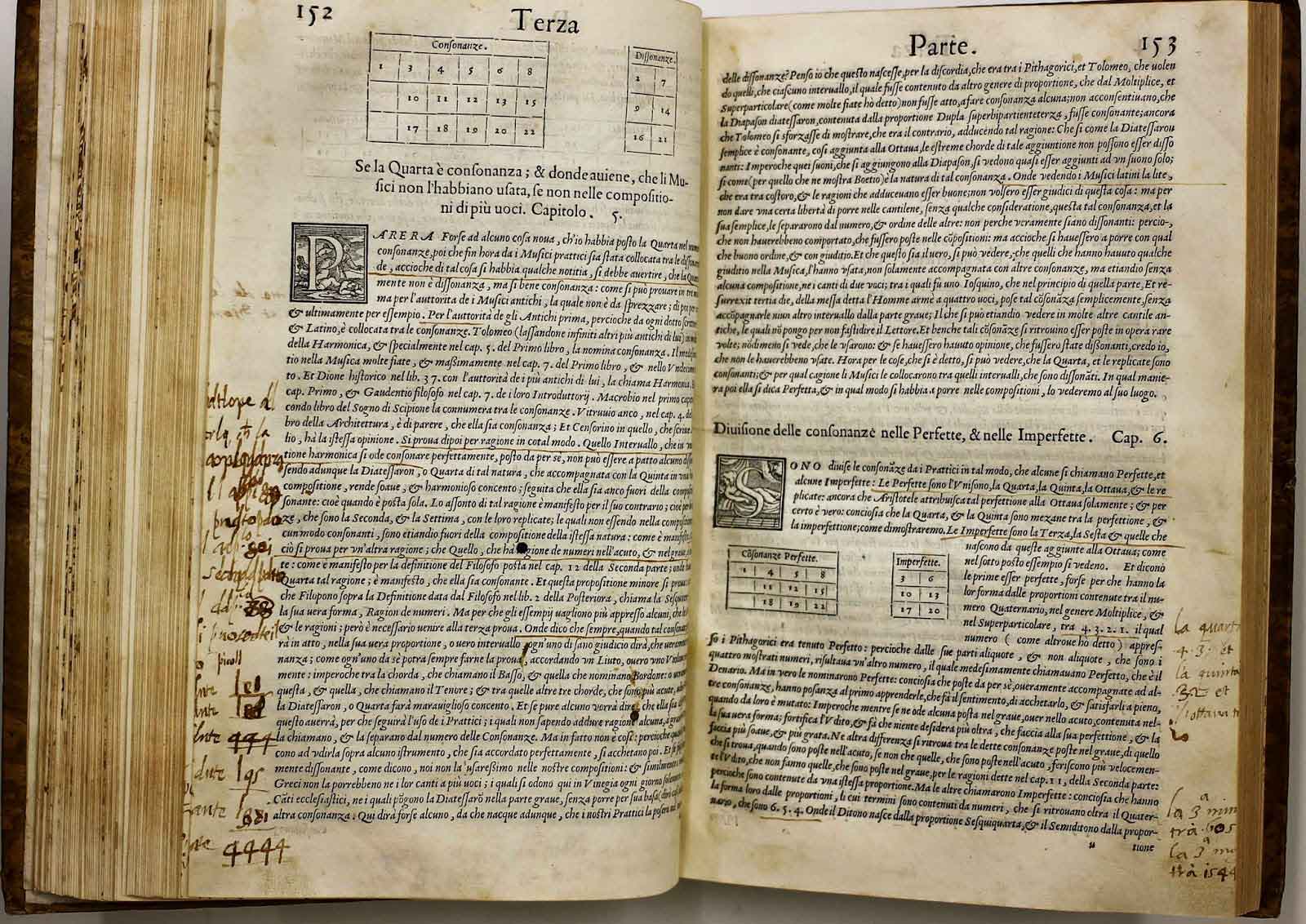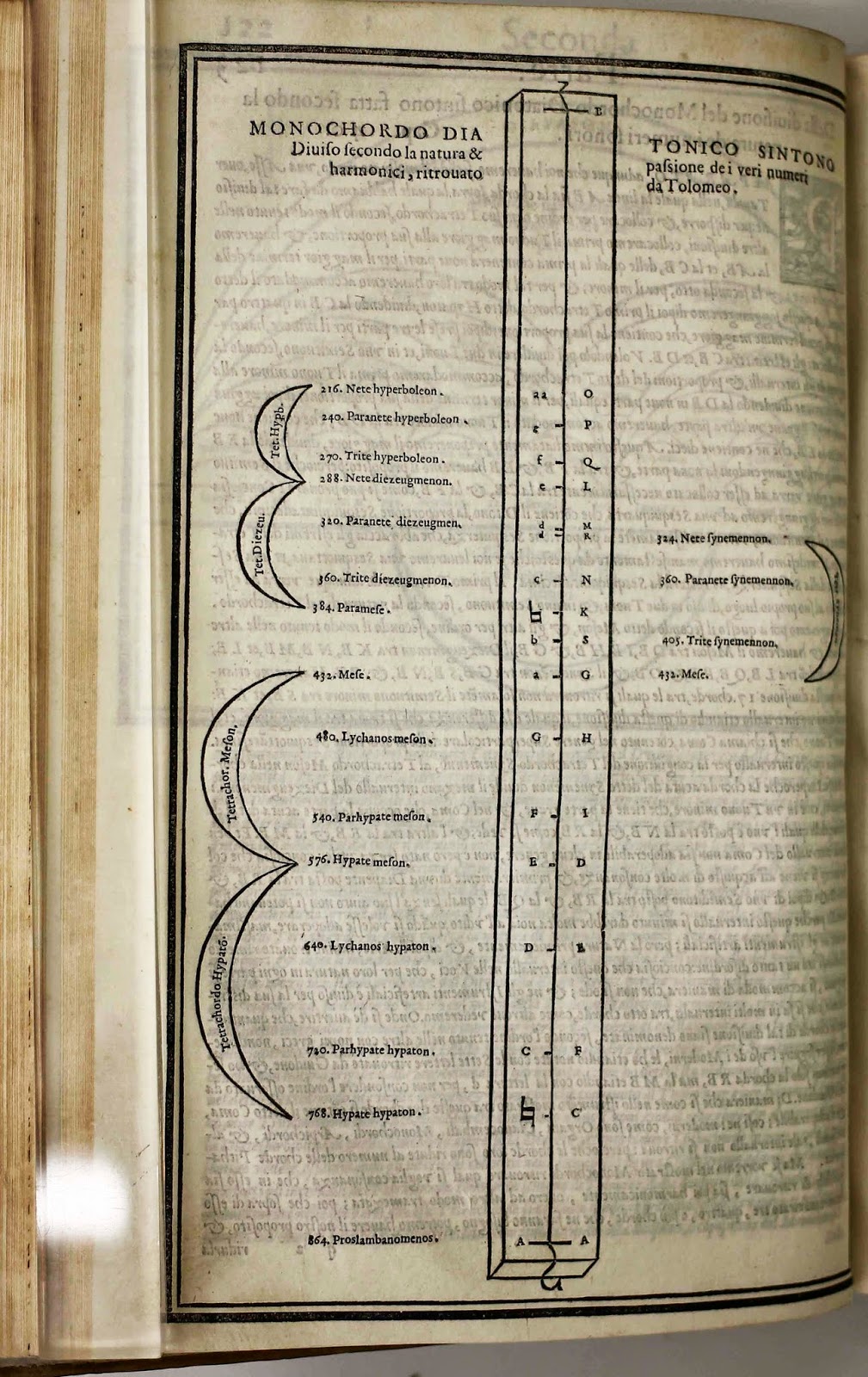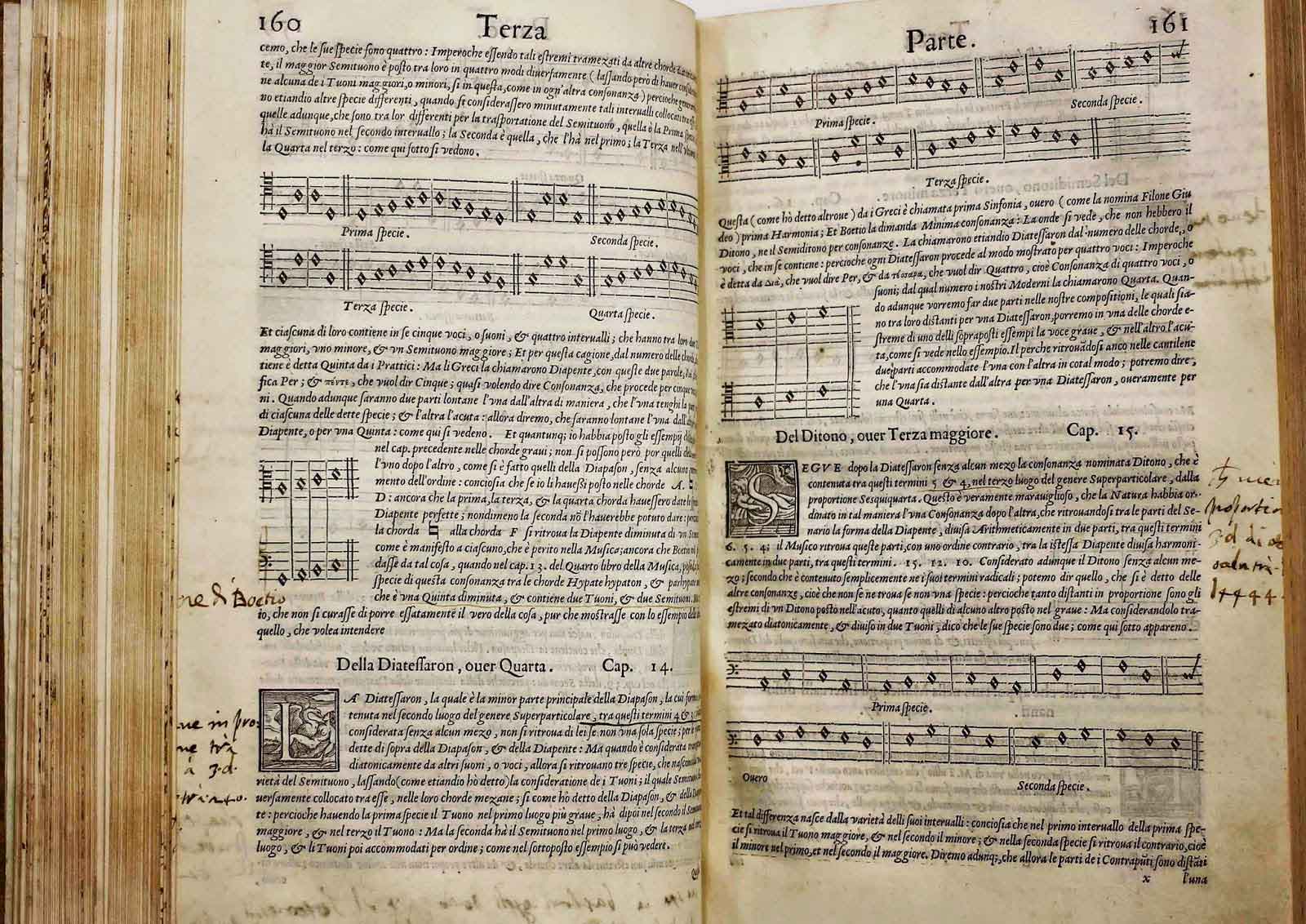Le Istitutioni Harmoniche by Gioseffo Zarlino, 1558
 December 1, 2014
December 1, 2014
Description by Hannah Spencer, graduate student in Musicology and Archives & Special Collections assistant.
One of the most important works in the history of music theory, Gioseffo Zarlino's 1558 treatise "Le Istitutioni Harmoniche" sought to unite music theory with the craft of composition. In his text, Zarlino teaches composers to study music using both reason and the senses in order to make their compositions more perfect. It was not enough to merely write music with a pleasing sound; Zarlino believed that a composer should also understand the scientific principles determining traits which make music appealing. As part of the The Walter F. and Alice Gorham Collection of Early Music Imprints, Brandeis University's Special Collections holds a unique copy of this groundbreaking treatise.
 Although not an uncommon text to find in university libraries, this particular copy — a second printing — is made uniquely fascinating by the handwritten annotations found throughout the text. The margins of 96 of the volume's 347 pages contain notes from the late 16th or early 17th century in at least two different hands. In some places, the writing has been crossed out using the same brown ink. These comments provide early responses to Zarlino's theories. Unfortunately, the outer edges of these annotations have been lost. This particular copy of "Le Istitutioni Harmoniche" was originally held in the library of Gualfardo Bercanovich, an Italian composer of the late 19th century. Each book in Bercanovich's library was identically bound. In the case of this Zarlino text, the trimming required for binding removed some of the commentary.
Although not an uncommon text to find in university libraries, this particular copy — a second printing — is made uniquely fascinating by the handwritten annotations found throughout the text. The margins of 96 of the volume's 347 pages contain notes from the late 16th or early 17th century in at least two different hands. In some places, the writing has been crossed out using the same brown ink. These comments provide early responses to Zarlino's theories. Unfortunately, the outer edges of these annotations have been lost. This particular copy of "Le Istitutioni Harmoniche" was originally held in the library of Gualfardo Bercanovich, an Italian composer of the late 19th century. Each book in Bercanovich's library was identically bound. In the case of this Zarlino text, the trimming required for binding removed some of the commentary.
 The text of "Le Istitutioni Harmoniche" is divided into four books. Book One reviews the "philosophical, cosmological and mathematical basis of music" [1]. Aside from summarizing traditional classifications of music, Zarlino's main focus in this section is the proper handling of mathematical proportions in music. Book Two builds upon this foundation by establishing Zarlino's preferred tuning system, syntonic diatonic tuning. This method was based on ratios proposed by Ptolemy and allowed for a greater number of in-tune consonances than the Pythagorean system also in use at the time. By dividing the string of a monochord into six parts instead of four, additional perfect consonances could be formed [2].
The text of "Le Istitutioni Harmoniche" is divided into four books. Book One reviews the "philosophical, cosmological and mathematical basis of music" [1]. Aside from summarizing traditional classifications of music, Zarlino's main focus in this section is the proper handling of mathematical proportions in music. Book Two builds upon this foundation by establishing Zarlino's preferred tuning system, syntonic diatonic tuning. This method was based on ratios proposed by Ptolemy and allowed for a greater number of in-tune consonances than the Pythagorean system also in use at the time. By dividing the string of a monochord into six parts instead of four, additional perfect consonances could be formed [2].
Arguably the most lasting portion of Zarlino's treatise, Book Three presents rules for counterpoint that were passed down through generations of composers and are still in use today. In this section, Zarlino adapts existing contrapuntal methods to allow for more modern tuning. He divides the useable intervals into specific groupings based on degrees of perfection, and establishes rules for voice leading and the placement of specific types of intervals. These are not rules invented by Zarlino, but passed down to him from his teacher, Adrian Willaert. However, Zarlino was the first to clearly articulate these rules in writing [3].

In the final section, Book Four, Zarlino discusses his 12-mode system. Again based on Willaert with significant influences from Glaurean, Zarlino expands the traditional Greek modal system from eight modes to 12. He also strips the modes of their traditional Greek names, simply identifying them by number. He discusses each mode in detail before ending his treatise with a rare discussion of the finer points of composition, such as text expression and underlay.
Aside from his work as a theorist, Zarlino served as the maestro di capella of St. Marco's Cathedral in Venice from 1565 until his death in 1590. He composed motets and madrigals and was the teacher of several important theorists, including Artusi, Merulo and Galilei. Although the majority of "Le Istitutioni Harmoniche" would eventually become outdated as compositional styles and theories of harmony shifted, Zarlino's rules for counterpoint are still relevant. His treatise laid the groundwork for the musical development to come.

Read the Spotlight on the entire Walter F. and Alice Gorham collection.
Notes
- Claude V. Palisca, "Zarlino, Gioseffo," Grove Music Online, Oxford University Press, Accessed Nov. 25, 2014.
- Claude V. Palisca, introduction to "The Art of Counterpoint," by Gioseffo Zarlino, trans. Guy A. Marco and Claude V. Palisca (New Haven: Yale University Press, 1968), xiii-xxvi.
- Ibid.